 |
| |
|
|
|
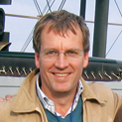 |
|
PETER McMILLAN took on many challenges when he spearheaded the Vimy project in 1992 with Lang Kidby. Deciding to build a replica of the World War I twin-engine biplane sidelined his career as an investment banker, and reenacting the Smith brothers’ 1919 landmark flight from England to Australia was often risky, especially when the aircraft crash-landed in Sumatra. Peter told the story of the adventure in the May 1995 National Geographic and in his first book, The Greatest Flight. After he resumed his career to help support the project, other crews flew the replica from England to South Africa and across the Atlantic. Peter’s second book, The Vimy Expeditions, brings together the compelling stories of all three original flights and their reenactments.
Peter’s fascination with aviation began when he was an eight-year-old and visited Kitty Hawk, North Carolina, site of the Wright brothers’ first powered flight. He then spent time reading and dreaming about “knights of the air,” building model airplanes, and peeking through airport fences to glimpse real flying machines. After moving to California in the early 1980s, he became involved with other enthusiasts devoted to restoring and flying antique aircraft. In 1990, Peter flew a 1942 Harvard (AT-6) trainer from England to Australia.
Peter’s last flight on the Vimy replica was also the biplane’s final flight. On November 15, 2009, he was in the cockpit for the replica’s journey to its retirement at the Brooklands Museum in Weybridge, England. “How wonderful it will be when a child comes to Brooklands,” Peter says, “looks up at our well-worn flying machine, at the maze of wires and the patches in the fabric, and the magical cycle begins again.”
|
|
| |
|
 |
|
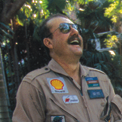 |
|
LANG KIDBY has always been interested in outdoor adventures. When he was young, he organized trips with school pals into the rainforest mountains behind Australia’s Gold Coast. At age 14, he acquired his first vehicle, a World War II army truck, which he drove on the deserted beaches of Stradbroke Island. As an adult, Lang continued to come up with one challenge after another. For more than 25 years, he and his wife, Bev, have organized expeditions around the world. On one such adventure, they completed a world circumnavigation, from Vladivostok to Anchorage, in a 1969 Fiat 500, the smallest vehicle to circle the world.
Aviation has been prominent in Lang’s life, including a 15-year stint as an Australian Army pilot. He partnered with Peter to launch the Vimy project and restored and flew a 1927 Avro Avian biplane solo from England to Australia. Lang’s piloting skills were critical to the Vimy project, as was his ability to cut through red tape across the world. He and Peter flew the replica Vimy on its first reenactment, from England to Australia. Lang’s fortitude lifted the plane from her crash site in Sumatra, a scene that to the less determined would have ended the project. |
|
| |
|
 |
|
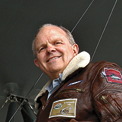 |
|
STEVE FOSSETT climbed his first mountain as a 12-year-old Boy Scout. For the next half century, he never stopped looking for new challenges. When in his teens, he discovered that he excelled at endurance activities and could reach ambitious goals through planning, training, and sheer tenacity. Success on Chicago’s trading exchanges later allowed him to embark on a second career as a record-setting adventurer—“doing interesting things,” as he liked to put it. These “things” included climbing Vinson Massif in Antarctica, swimming the English Channel, and completing the Iditarod Trail Sled Dog Race.
By the early 1990s, Steve began to focus on achieving significant world records and firsts, such as world records in sailing and the first ocean and continent crossings by balloon. He also held transcontinental and global speed and distance records in powered aircraft. Topping his list of 116 major records and firsts are the extraordinary first solo round-the-world balloon flight and the first solo, nonstop, nonrefueled, round-the-world airplane flight. Steve was a superb partner and pilot for the Vimy Atlantic project , which proved to be the ultimate test of skill, concentration, and endurance as he guided the Vimy replica for 16 hours through the darkness and clouds above the ocean.
Steve died in a light aircraft accident on September 3, 2007. |
|
| |
|
 |
|
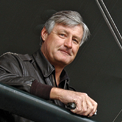 |
|
MARK REBHOLZ is unable to recall a time when he wasn’t enthralled with every aspect of aviation. As a child, he pored over aviation-related books in school libraries and imagined himself flying alongside his heroes. At age 13, he had his first flying lessons—in gliders. By the time he was a young adult, Mark had his commercial pilot certificate and was earning a living as a pilot. Toward the end of the Vietnam War, he flew as a boom operator on KC-135s in the US Air Force and was introduced to airborne celestial navigation. Over the years, he has flown as a mail pilot in well-worn Beech 18s and earned captain’s stripes as a pilot for United Airlines.
Mark’s experience and expertise were critical to all the Vimy expeditions, for which he served as flight ops manager, logistics coordinator, support plane pilot, mechanic, and diplomat. He was a pilot on the flight from England to South Africa and navigator and copilot for the Atlantic crossing. “I was choked up with emotion thinking about what we had just accomplished,” Mark writes about reaching Ireland. “By flying the Atlantic, England to Australia, and England to Cape Town, the Vimy replica had accomplished what no other airplane had done.” |
|
| |
|
 |
|
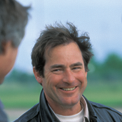 |
|
JOHN LaNOUE, born and raised in Northern California, has had a lifelong fascination with crafting wondrous and useful things. Having made this discovery at a young age, he immersed himself in reading about tools and construction, then honed his skills and applied them to building many objects, including several small boats. At age 18, he left the confines of a formal education and went to Latin America, where he traveled for a year and learned the art of wood sculpting. Upon returning to the United States, he launched his career as a sculptor and industrial artist working in the theater and film industries.
John developed a fascination for flying late in life, at age 32. In addition to leading the original construction team in building the Vimy replica—which took 18 months and 30,000 man-hours—John completed the two subsequent engine retrofits largely on his own. He also flew as copilot from England to South Africa in 1999, reenacting the historic flight of 1920. “When it all began as nothing more than an idea,” John writes, “I could never have imagined the extent to which the Vimy’s creation would influence so many lives and how so many people would be inspired by it.” |
|
 |
| |
 |
PETER McBRIDE was the photographer and more on the 1999 England to South Africa flight . His efforts and those of his Kenya-based friends made it possible to clear Africa’s seemingly insurmountable mountains—and the mountains of red tape to cross Ethiopia into Kenya. His story about the flight was in the May 2000 National Geographic, and his complete description of the journey, along with his photos, appears in The Vimy Expeditions. Whether a trip involves antique aviation, climbing, or surfing, Peter is always keen to go a remote corner of the globe. He has traveled in more than 40 countries. When at home in Colorado, he flies a Piper SuperCub. |
|
 |
DAVID R. HOLBROOKE met the impassioned Vimy crew in 1997, following the flight from England to Australia, and soon became involved in the subsequent flights to South Africa and across the Atlantic. Affectionately called “The Fueller” by his Vimy cohorts, he worked tirelessly to complete the project’s complex and expensive adventures. When others doubted the outcome of a thorny problem, David would buoy the team and then divine a solution. Inspired by the uplifting energy of the machine, he devoted time and energy to spreading the spirit of the project to schoolchildren around the world. Under David’s guidance, the educational programs associated with the flights proved highly successful at stimulating the pioneers of tomorrow.
|
|
| |
 |
JOHN OWEN met Peter McMillan in 1989, and the two realized that they shared an interest in aviation and high adventure. Both enjoyed flying vintage aircraft, in John’s case a 1941 de Havilland Tiger Moth. After Peter and Lang conceived the Vimy project in 1992, John became essential to the project. Having founded his own publishing company in 1985, he understood the worlds of corporate sponsors and public relations. He had already undertaken such monumental projects as photographing the interior of mainland China from balloons and producing an aerial picture book of Europe. He also had developed a close relationship with National Geographic. Without John’s initiative and expertise, Peter’s new book, The Vimy Expeditions, would not have been possible. |
|
 |
JENNY MOSELEY worked at National Geographic during her 25-year career there to help make record-setting expeditions a success. When assigned to the National Geographic Society team on the first flight of the Vimy replica, from England to Australia, she jumped at the chance, not realizing that she would be closely involved with the subsequent flights, from England to South Africa and across the Atlantic. During this 15-year adventure, she was present at two takeoffs and three landings, an honor surpassed only by Mark Rebholz. Jenny raised sponsorship funds, gave countless interviews and lectures, and planned logistics. She inspired hundreds of volunteers to give their time and nurtured the young people who followed the South African flight and affectionately called her the “Silver Queen Mum.”
|
|
|
|
| | |
|
 |